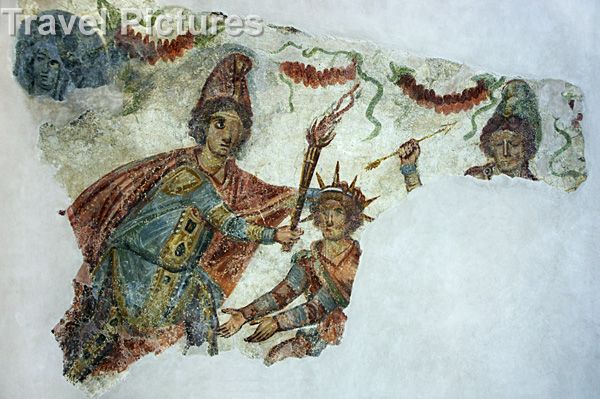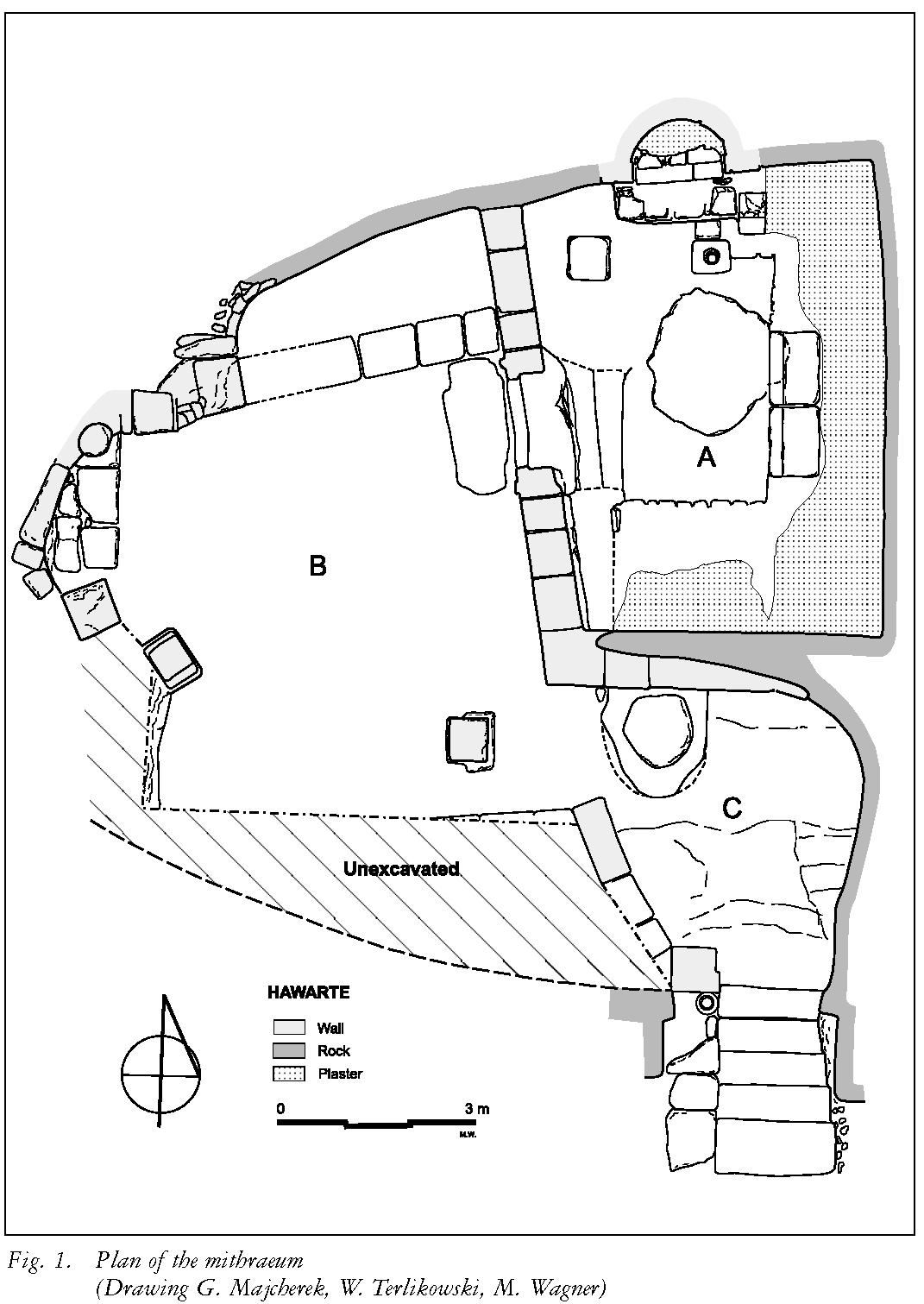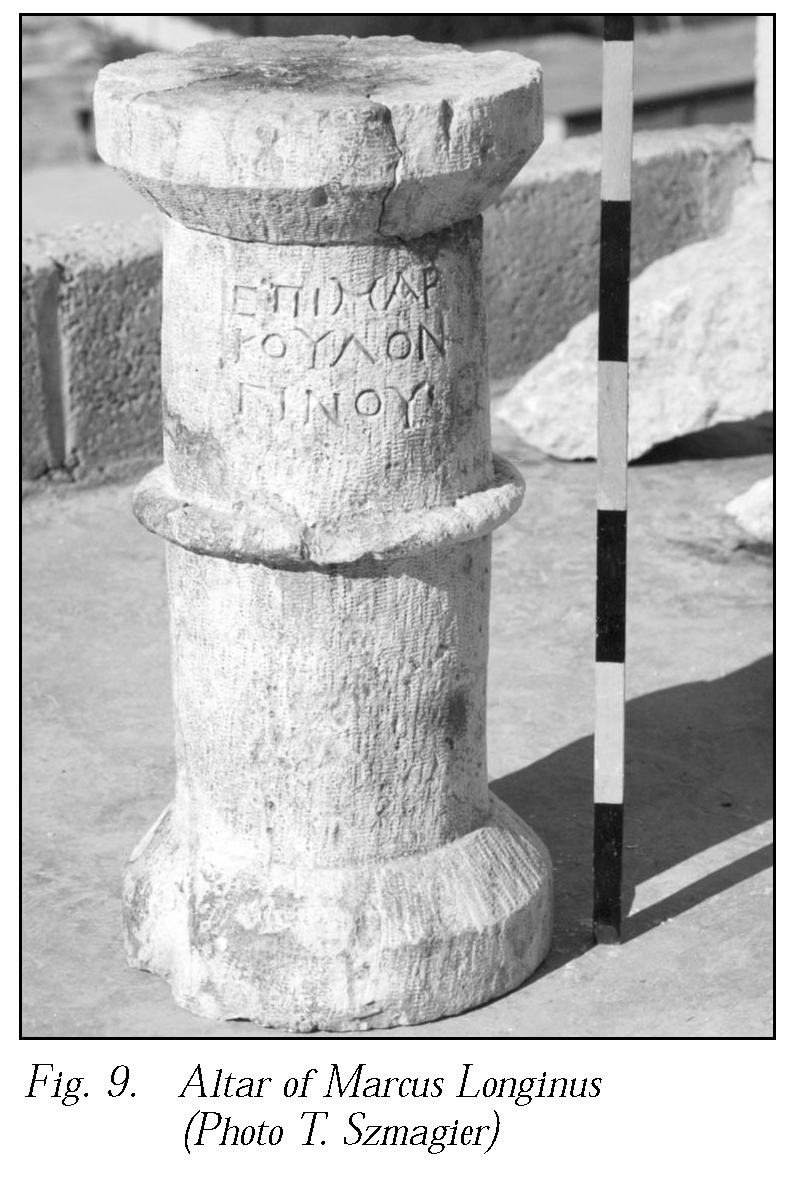
CIMRM Supplement - Mithraeum with brilliant paintings. Hawarte / Hawarti, Syria.

A mithraeum was discovered at Hawarti in Syria in 1996-7, underneath a ruined church, when part of the church floor collapsed into it. The room is characterised by brilliant paintings. The mithraeum appears to have been one of the latest in use anywhere in the Roman empire. A curious feature of the temple is that on 25 Dec. a ray shines into it, falling on the niche in which the cult image must have stood.1
Coordinates: 35° 25' 05" N, 36° 23' 53" E / 35.418° N, 36.398° E.2
1. Discovery
The village of Hawarti (or Huarte) is 15km north of Apamea. An important church complex was excavated there in the 1970s. The church was built in the 480s by Archbishop Photios of Apamea and paved with mosaics. The church was a rebuilding of an earlier church, also with mosaics, built at the end of the 4th century. The mosaics were removed to a museum. During the winter of 1996-7, part of the floor collapsed, revealing a chamber, which was excavated by robbers who removed a painting. They also found a painted ceiling, but this proved impossible to remove. The Syrian authorities quickly arrested the robbers, and the painting is now in the museum in Damascus. A Dutch archaeologist visited the site in September 1997 and photographed what he could see. A team of Polish archaeologists led by M. Gawlikowski was assigned to begin excavations in August 1998. They found that paintings on the East wall visible in Sept. 1997 had already vanished through robbery and exposure. The Syrian authorities decided to preserve the site in situ and make it accessible to the public. Further seasons of work were undertaken with this in mind.3
2. Size and date
The main chamber is 4.80 m wide, east-west. It is 6.45 m long on the west wall, and 7.20 m on the east wall, north-south. The east wall is the original rock wall of the natural cave.
There is no left-hand bench. The right hand bench runs to the south side of the room and then angles along the south side.

There is a niche in the middle of the north wall, 1.38m wide and raised above the chamber floor. This must have contained the relief of the tauroctony, which has not been found but may be in the unexcavated area. A podium stood before it, and later a small pedestal was added to the right hand side of the podium, with two steps leading up to it. In front of the podium, and to the right, stood an altar, which was found lying face-down.
The central floor-space is slightly concave. There seems to be a hollow space below, and small openings lead into it, presumably for drainage.
A wall of 8 large courses of stone was built inside the chamber to support the church above it, some 3.5m higher. This wall was removed by the excavators.4
The walls and the niche were plastered, and painted. In places up to six layers of paint have been found. The last two layers of painting go over the podium and pedestal, and are dateable, by the fill in the steps in front of the podium, to not earlier than ca. 360 AD.
In the final phase of use, the entire northern, western and eastern wall was painted, as well as the structures in front of the niche.
Two layers of earth were found in the floor. A coin of Diocletian was found in the lower level, possibly indicating the date of foundation of the mithraeum.

A number of coins were found in the upper layer, all 4th century, and the latest one of Arcadius (AD 383 onwards). Lamps and pottery belonging to the same period were found. It is inferred from this that the mithraeum remained in use until the last years of the 4th century, when it was destroyed and a church built over it. Since the latest dateable mithraic monument is an inscription from Rome from 387 AD, and the Sidon artefacts possibly 389 AD, this suggests that the Hawarti mithraeum was the last known mithraeum in use.5
Various stone altars, all overturned, were found on the floor.
There is a door to the ante-chamber in the middle of the west wall.
The entrance to the ante-chamber was in the south side of the ante-chamber.
3. Light on Mithras on 25 Dec.
There is a horizontal gap in the west wall of the main chamber, looking into the ante-chamber. Experiments have shown that light through this source will fall on the niche, and specifically on the face of Mithras (if a tauroctony relief of normal proportions was present in it) throughout December and up to January 6th.6
4. Paintings
Both the main chamber and ante-chamber are richly painted on all the walls that we can see.
4.1. Main chamber
The band of painting containing figures is 110 cm high, with a wide red band above it to the ceiling. Below this is a dado of geometric patterns, which also covers the podium.

The scenes to the right of the niche depict, from the left:
1. Zeus battling the giants. The god is poorly preserved, but wearing cloak and boots. Two monsters are on either side of him, nude, with human legs ending in serpents winding up above them. The heads are lost.
2. A victorious Zeus is shown in the north-eastern corner of the cave, to the right of the battle, seated on a throne inside a circular wreath.
3. On the eastern wall, next, is Mithras depicted as a young man emerging from the rock, around which a huge serpent is coiled. He is depicted nude but holding his phrygian cap in his hand.
4. A nude boy in a cypress tree, again with a phrygian cap.
5. A huge fully-dressed figure of the Sun god, with raised hands.
6. Further along the east wall, the paintings are almost completely lost. A fragment might represent a bull upside down being carried by Mithras.
Gawlikowski suggests that the series may be intended to identify Mithras with other gods, i.e. Apollo, Attis and Sol.

To the left of the niche, from the right:
1. A city wall with an arched gate. Over the top of the wall, there is a row of hideous and dreadful heads, with shaggy hair and teeth being ground. Each is stricken by a long yellow line, apparently a ray of light. One of the heads has already fallen to the ground outside the gate.
2. A richly clad man standing next to a huge horse, with a demon at his feet in chains.
3. Another figure (indistinct).
In the south-west corner of the room is a hunting scene.
On the south wall are fragments of a poorly preserved mural, showing a horse moving to the right and three sets of Persian hair-styles, perhaps indicating a line of advancing riders.

The eyes of the figures have been scratched out, presumably by the masons who built the church.
The ceiling painting was symmetrical and had an elaborate frame. Inside was a basket of grapes flanked by two birds (peacocks?) and two disks. On an earlier layer of painting there must have been a picture of Mithras, for a fragment of plaster with his name in large Greek letters was recovered.
There is no bench under the depiction of the demons. The right bench was found. There are also remains of the last ritual meals, consisting of chicken and pork. Several lamps and lamp fragments, in pottery and glass, of the 4-5th c. were found.
4.2. Ante-chamber

On the north wall is a scene of two lions, opposite each other, tearing apart black human figures. The lion bodies are poorly preserved. The lower bodies of the humans are better preserved, clad in a short skirt, one red, one green. A third black is shown with blood from his mouth, but his skirt is not preserved.
On the east wall, north of the doorway, is a further mural. There is a huge white horse passing to the right, one of its forelegs lifted. The hoof is partly concealing a four-legged stand or altar, around which a serpent is coiled. In front of the horse there stands a magnificent figure of a man preserved from his waist down. He wears a red tunic reaching to the knees, adorned in front with a band set with precious stones between two vertical rows of pearls. The tunic is passed over his trousers, of which each leg is likewise knit. The most striking particularity of this mural is, however, the wretched fellow held on a chain by the heroic figure. The chain is double, reaching from the hand of the rider to each of the wrists of a Negro, who is entirely naked and shown from behind, crouching. The figure is preserved whole, so it is very clear that the otherwise normal body has two distinct heads, turned in opposing profiles and wearing metal collars on the neck.
5. Altar of Marcus Longinus
Very few objects associated with the mithraeum were recovered. Only one of the several votive altars is inscribed, apparently in the course of the 2nd century. It bears the name of one Marcus Longinus, in Greek.
The feet of a statuette may have belonged to a lion-headed deity.
6. Bibliography
- M. Gawlikowski, "Hawarti: Preliminary Report", Polish Archaeology in the Mediterranean 10 (Reports 1998), 1999, 197-204 (online here).
- PMCA Newsletter 2006. Online here. Detailed discussion of the conservation with pictures.
- M. Gawlikowski, "The mithraeum at Hawarte and its paintings," Journal of Roman Archaeology. Vol 20 (2007) No. ?, pp. 337-361.
- All the Polish Archaeological Mission reports (in English).
- Blog of the Polish conservators, showing the reassembly of paintings..
- KKadu's gallery of images.
- Eric Moorman, Divine Interiors, p.180.
| 1 | The excavation reports by M. Gawlikowski are the source for all these statements. |
| 2 | Supplied by John W. Brandt - thank you. |
| 3 | PAM 10, p.197-9. |
| 4 | PAM 10-11. |
| 5 | PAM 10. |
| 6 | Popular explanation (in Polish) at Archeowiesci. |
| Tweet |



